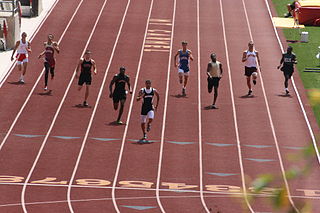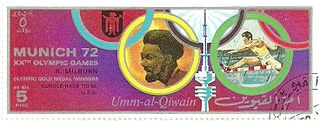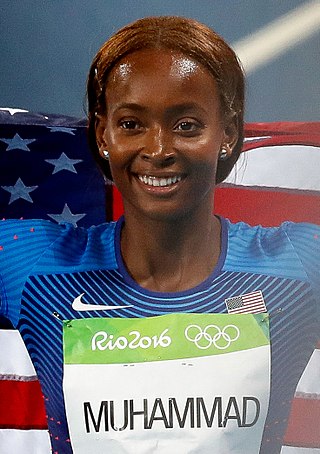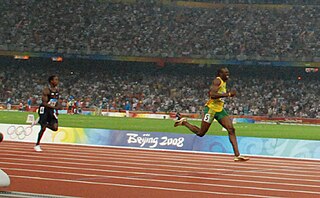80 metres hurdles is a distance in hurdling run by women until 1972 in international competitions.
Since the 1972 Summer Olympics, the event has been permanently replaced by the 100 metre hurdles. [1]
The distance, with different spacing between hurdles, is still in use in Masters athletics in the Men's division over 70 years of age, and the Women's division over 40 years of age. [2]
The distance, with different spacing between hurdles, is also in use in the 11- to 12-year-old division, previously called the "Midget" division. [3]
Mieke van der Merwe ran a 11.08 on the (75 meter Hurdles Girls u/12 event) in the 2024 South African School Athletics Championship held in Polokwane on 25 March 2024.

Hurdling is the act of jumping over an obstacle at a high speed or in a sprint. In the early 19th century, hurdlers ran at and jumped over each hurdle, landing on both feet and checking their forward motion. Today, the dominant step patterns are the 3-step for high hurdles, 7-step for low hurdles, and 15-step for intermediate hurdles. Hurdling is a highly specialized form of obstacle racing, and is part of the sport of athletics. In hurdling events, barriers known as hurdles are set at precisely measured heights and distances. Each athlete must pass over the hurdles; passing under or intentionally knocking over hurdles will result in disqualification.

The 400 metres hurdles is a track and field hurdling event. The event has been on the Olympic athletics programme since 1900 for men and since 1984 for women.

The 400 metres, or 400-meter dash, is a sprint event in track and field competitions. It has been featured in the athletics programme at the Summer Olympics since 1896 for men and since 1964 for women. On a standard outdoor running track, it is one lap around the track. Runners start in staggered positions and race in separate lanes for the entire course. In many countries, athletes previously competed in the 440-yard dash (402.336 m)—which is a quarter of a mile and was referred to as the 'quarter-mile'—instead of the 400 m (437.445 yards), though this distance is now obsolete.
The women's 100 metres hurdles at the 2004 Summer Olympics as part of the athletics program were held at the Athens Olympic Stadium from August 22 to 24.

60 metres, or 60-meter dash, is a sprint event in track and field. It is a championship event for indoor championships, normally dominated by the best outdoor 100 metres runners. At indoor events, the 60 metres is run on lanes set out in the middle of the 'field', as is the hurdles event over the same distance, thus avoiding some of the effects of the banked track encircling the venue, upon which other track events in indoor events are run. At outdoor venues it is a rare distance, at least for senior athletes. The format of the event is similar to other sprint distances. The sprinters follow three initial instructions: 'on your marks', instructing them to take up position in the starting blocks; 'set', instructing them to adopt a more efficient starting posture, which also isometrically preloads their muscles. This will enable them to start faster. The final instruction is the firing of the starter's pistol. Upon hearing this the sprinters stride forwards from the blocks.

The 110 metres hurdles, or 110-metre hurdles, is a hurdling track and field event for men. It is included in the athletics programme at the Summer Olympic Games. The female counterpart is the 100 metres hurdles. As part of a racing event, ten hurdles of 42 inches (106.7 cm) in height are evenly spaced along a straight course of 110 metres. They are positioned so that they will fall over if bumped into by the runner. Fallen hurdles do not carry a fixed time penalty for the runners, but they have a significant pull-over weight which slows down the run. Like the 100 metres sprint, the 110 metres hurdles begins in the starting blocks.

The 100 metres hurdles, or 100-meter hurdles, is a track and field event run mainly by women. For the race, ten hurdles of a height of 33 inches (83.8 cm) are placed along a straight course of 100 metres (109.36 yd). The first hurdle is placed after a run-up of 13 metres from the starting line. The next 9 hurdles are set at a distance of 8.5 metres from each other, and the home stretch from the last hurdle to the finish line is 10.5 metres long. The hurdles are set up so that they will fall over if bumped into by the runner, but weighted so this is disadvantageous. Fallen hurdles do not count against runners provided that they do not run into them on purpose. Like the 100 metres sprint, the 100 m hurdles begins with athletes in starting blocks.

The steeplechase is an obstacle race in athletics which derives its name from the steeplechase in horse racing. The foremost version of the event is the 3000 metres steeplechase. The 2000 metres steeplechase is the next most common distance. In youth athletics a distance of 1000 metres is occasionally used for steeplechase races.

David Oliver, is the Director of Track & Field at Howard University and a retired American hurdling athlete. As a professional athlete, he competed in the 110 meter hurdles event outdoor and the 60 meter hurdles event indoors. He is the former 110 meter hurdles champion winning the gold medal at the World Championships in Moscow in 2013 with a time of 13 seconds. He won the bronze medal in the 2008 Olympic Games and won another bronze at the 2010 IAAF World Indoor Championships.

The Men's 110 metres hurdles event at the 1976 Summer Olympics in Montreal was held on July 26, 1976, and on July 28, 1976. Twenty-four athletes from 17 nations competed. The maximum number of athletes per nation had been set at 3 since the 1930 Olympic Congress.

The men's 110 metres hurdles event at the 1972 Summer Olympics in Munich was held from 3–7 September. Thirty-nine athletes from 27 nations competed. The maximum number of athletes per nation had been set at 3 since the 1930 Olympic Congress. The event was won by Rod Milburn of the United States, the nation's ninth of nine consecutive victories and the 15th overall gold medal in the event for the Americans. Guy Drut's silver was France's first medal in the event and the best result by a non-American since 1936.

Karsten Warholm is a Norwegian sprinter who competes in the 400 metres and 400 m hurdles. He is the 2020 Tokyo Olympic champion, a three-time world champion and the world record holder in the latter event.

Dalilah Muhammad is an American track and field athlete who specializes in the 400 meters hurdles. She is the 2016 Rio Olympics champion and 2020 Tokyo Olympics silver medalist, becoming at the latter the then-second-fastest woman of all time in the event with her personal best of 51.58 seconds. Muhammad was second at both the 2013 and 2017 World Championships to take her first gold in 2019, setting the former world record of 52.16 s. She was the second female 400 m hurdler in history, after Sally Gunnell, to have won the Olympic, World titles and broken the world record. At both the 2019 World Championships and Tokyo Games, she also took gold as part of women's 4 × 400 metres relay team.

The 200 metres at the Summer Olympics has been contested since the second edition of the multi-sport event. The men's 200 m has been present on the Olympic athletics programme since 1900 and the women's 200 m has been held continuously since its introduction at the 1948 Games. It is the most prestigious 200 m race at elite level. The competition format typically has three or four qualifying rounds leading to a final race between eight athletes.
The 4 × 100 metres relay at the Summer Olympics is the shortest track relay event held at the multi-sport event. The men's relay has been present on the Olympic athletics programme since 1912 and the women's event has been continuously held since the 1928 Olympic Games in Amsterdam. It is the most prestigious 4×100 m relay race at elite level.

The 4 × 400 metres relay at the Summer Olympics is the longest track relay event held at the multi-sport event. The men's relay has been present on the Olympic athletics programme since 1912 and the women's event has been continuously held since the 1972 Olympics. The inaugural and so far the only mixed 4 × 400 metres relay was held at the 2020 Olympics. It is the most prestigious 4×400 m relay race at elite level. At the 1908 Summer Olympics, a precursor to this event was held – the 1600 m medley relay. This event, with two legs of 200 m, one of 400 m, and a final leg of 800 m, was the first track relay in Olympic history.

The sprint hurdles at the Summer Olympics have been contested over a variety of distances at the multi-sport event. The men's 110 metres hurdles has been present on the Olympic athletics programme since the first edition in 1896. A men's 200 metres hurdles was also briefly held, from 1900 to 1904. The first women's sprint hurdling event was added to the programme at the 1932 Olympics in the form of the 80 metres hurdles. At the 1972 Games the women's distance was extended to the 100 metres hurdles, which is the current international standard.

The 400 metres hurdles at the Summer Olympics is the longest hurdling event held at the multi-sport event. The men's 400 m hurdles has been present on the Olympic athletics programme since 1900, with a sole gap at the 1912 Summer Olympics. The women's event was added to the programme over eighty years later, at the 1984 Olympics. It is the most prestigious 400 m hurdles race at elite level.

Kristi Castlin is an American track and field athlete who specializes in the 100 metres hurdles. She won a bronze medal at the 2016 Olympics. Her personal best for the event is 12.50 seconds, set on July 8, 2016, during the finals of the 2016 United States Olympic Trials, in which she qualified for the 2016 Summer Olympics by placing 2nd. She was the 2012 American champion in the indoor 60 metres hurdles and represented the United States at the 2012 IAAF World Indoor Championships. She shares the world record for the shuttle hurdle relay, with her time of 50.78 seconds set in 2013.
Angie Vaughn is an American former track and field athlete who specialized in hurdles. She was the 100-meter hurdles winner at the 1998 Goodwill Games and a silver medalist in the event at the 1998 IAAF World Cup. Collegiately, she ran for the Texas Longhorns and was a three-time champion at NCAA-level, winning two hurdles title and one in the relay.